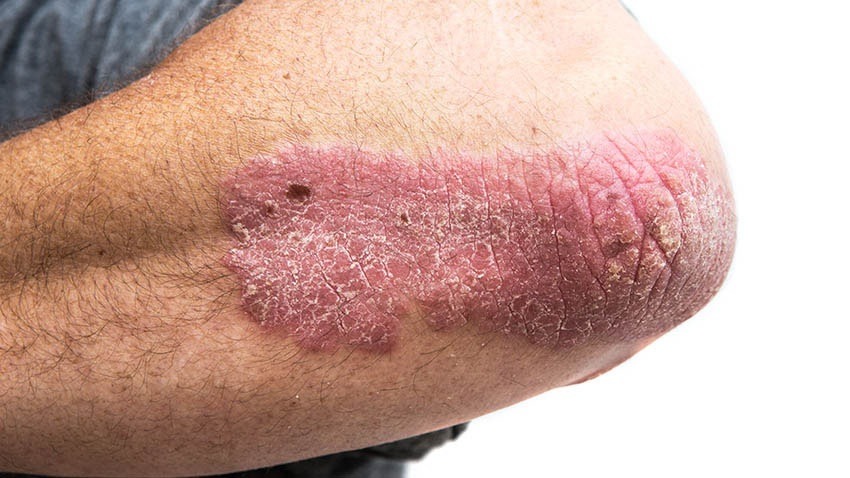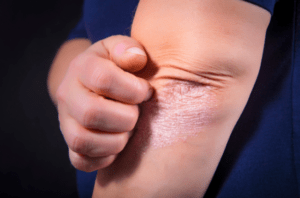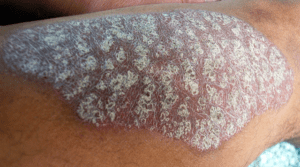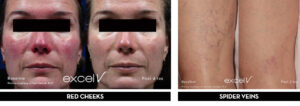
Psoriasis Seasonal Flare-Ups
 What is Psoriasis?
What is Psoriasis?
Psoriasis is a skin disease that causes red, scaly skin that may feel painful, swollen or hot.
Who Can Get It?
Anyone can get psoriasis, but it is more common in adults. Certain genes have been linked to psoriasis, so you are more likely to get it if someone else in your family has it. There are different types of psoriasis.
- Plaque psoriasis, which causes patches of skin that are red at the base and covered by silvery scales.
- Guttate psoriasis, which causes small, drop-shaped lesions on your trunk, limbs, and scalp. This type of psoriasis is most often triggered by upper respiratory infections, such as strep throat.
- Pustular psoriasis, which causes pus-filled blisters. Attacks or flares can be caused by medications, infections, stress, or certain chemicals.
- Inverse psoriasis, which causes smooth, red patches in folds of skin near the genitals, under the breasts or in the armpits. Rubbing and sweating can make this type of psoriasis worse.
- Erythrodermic psoriasis, which causes red and scaly skin over much of your body. This can be a reaction to a bad sunburn or taking certain medications, such as corticosteroids. It can also happen if you have a different type of psoriasis that is not well controlled. This type of psoriasis can be very serious, so if you have it, you should see a doctor immediately.
About 30% of patients with psoriasis develop psoriatic arthritis. The most common symptom is morning stiffness. If this is happening, even with mild skin involvement, it may require more aggressive therapy to prevent permanent joint damage over time.
 What Does It Look and Feel Like?
What Does It Look and Feel Like?
Psoriasis usually causes patches of thick, red skin with silvery scales that itch or feel sore. These patches can show up anywhere on your body, but they usually occur on the elbows, knees, legs, scalp, lower back, face, palms, and soles of your feet. They can also show up on your fingernails and toenails, genitals, and inside your mouth.
Psoriasis is an autoimmune disease, which means that your body’s immune system — which protects you from diseases — starts overacting and causing problems. If you have psoriasis, a type of white blood cells called the T cells become so active that they trigger other immune system responses, including swelling and fast turnover of skin cells.
Your skin cells grow deep in the skin and rise slowly to the surface. This is called cell turnover, and it usually takes about a month. If you have psoriasis, though, cell turnover can take only a few days. Your skin cells rise too fast and pile up on the surface, causing your skin to look red and scaly.
What Causes Flare-Ups?
Some things may cause a flare, meaning your psoriasis becomes worse for a while, including:
- stress
- infection
- medications
- cuts, scratches or sunburns
- a change in seasons
What Are Seasonal Flare-Ups?
Changes in weather can also factor into psoriasis flare-ups. Now that we’re entering the fall and winter seasons here in San Antonio, those suffering from psoriasis may be experiencing these flares. The American Academy of Dermatology offers these tips for seasonal psoriasis flares.
- Limit showers and baths to 10 minutes and use warm — rather than hot — water.
- Immediately after bathing, apply moisturizer, using a fragrance-free ointment or cream rather than a lotion.
- Use a gentle, moisturizing cleanser instead of soap.
- Apply moisturizer throughout the day when your skin feels dry.
- Plug in a humidifier when the air in your home feels dry.
- Stay warm and protect your skin from extreme weather when outside by wearing a hat, gloves, waterproof boots, and a jacket.
- Sit far enough away from a fireplace, radiator or other heat source so that you don’t feel the heat on your skin.
- Remove wet clothes and footwear when you come in from the cold.
- If your psoriasis continues to flare, see the professionals at DeSilva Dermatology.
Professional Treatment
Fortunately. there are several different types of treatment for the condition. Not only are there topical treatments, there also are systemic treatments that may offer relief. Dr. DeSilva can recommend that you try one of these or a combination.
- Topical treatment (putting creams on your skin).
- Systemic treatment, which includes taking prescription medications or getting shots of medicine.
Dr. DeSilva says, “There has been an explosion of new treatment options approved for psoriasis over the last 20 years. At this point we should be able to control your psoriasis so that psoriasis doesn’t control you. Let us come up with a customized treatment regimen to fit your severity, lifestyle, and based on your other medical conditions.”

 Next Post
Next Post




